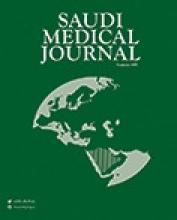Abstract
OBJECTIVE: To study the incidence, types, and sites of neural tube defects (NTDs) and its associated maternal and environmental variables.
METHODS: All preterm and full term live and stillborn babies delivered at Al-Ramadi Maternity and Children's Hospital, Al-Anbar Governorate, Iraq, from the 1st of November 2007 to the 1st of November 2008 were examined for gender, gestational age, NTDs, and associated congenital malformations. Mother's data included age, parity, consanguinity, education, antenatal care, previous medical illnesses, other NTDs history, folic acid supplementation, and diagnostic ultrasound. Incidence was calculated per 1000 births.
RESULTS: During the study, 33 infants were delivered with NTDs, giving an incidence of 3.3/1000 births. Most were of myelomeningocele and anencephaly types, and thoracolumbar and lumbosacral sites. Two-thirds of the cases found were from consanguineous marriage, 12 NTD's mothers took folic acid during their pregnancy, while none of them received the drug during the periconceptional period. Three mothers had another NTD affected babies before, and mothers 25-34 years old produced most of the NTD deliveries than any other age groups.
CONCLUSION: The NTDs incidence is still high compared with developed, and some developing countries. High consanguinity marriage and 100% lack of periconceptional folic acid intake needs further study considerations to reduce such morbid and mortal anomalies.
- Copyright: © Saudi Medical Journal
This is an open-access article distributed under the terms of the Creative Commons Attribution-Noncommercial License (CC BY-NC), which permits unrestricted use, distribution, and reproduction in any medium, provided the original work is properly cited.






